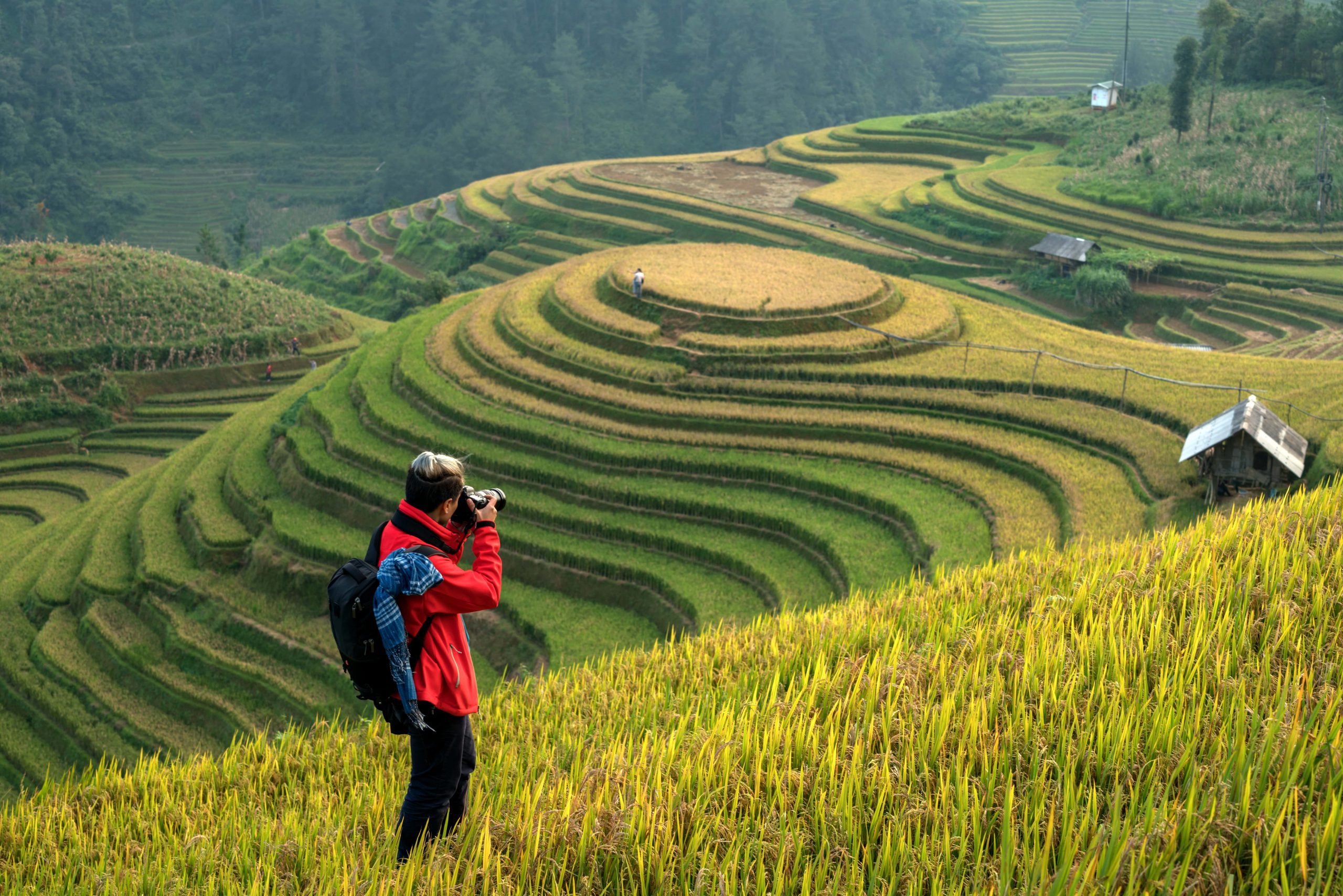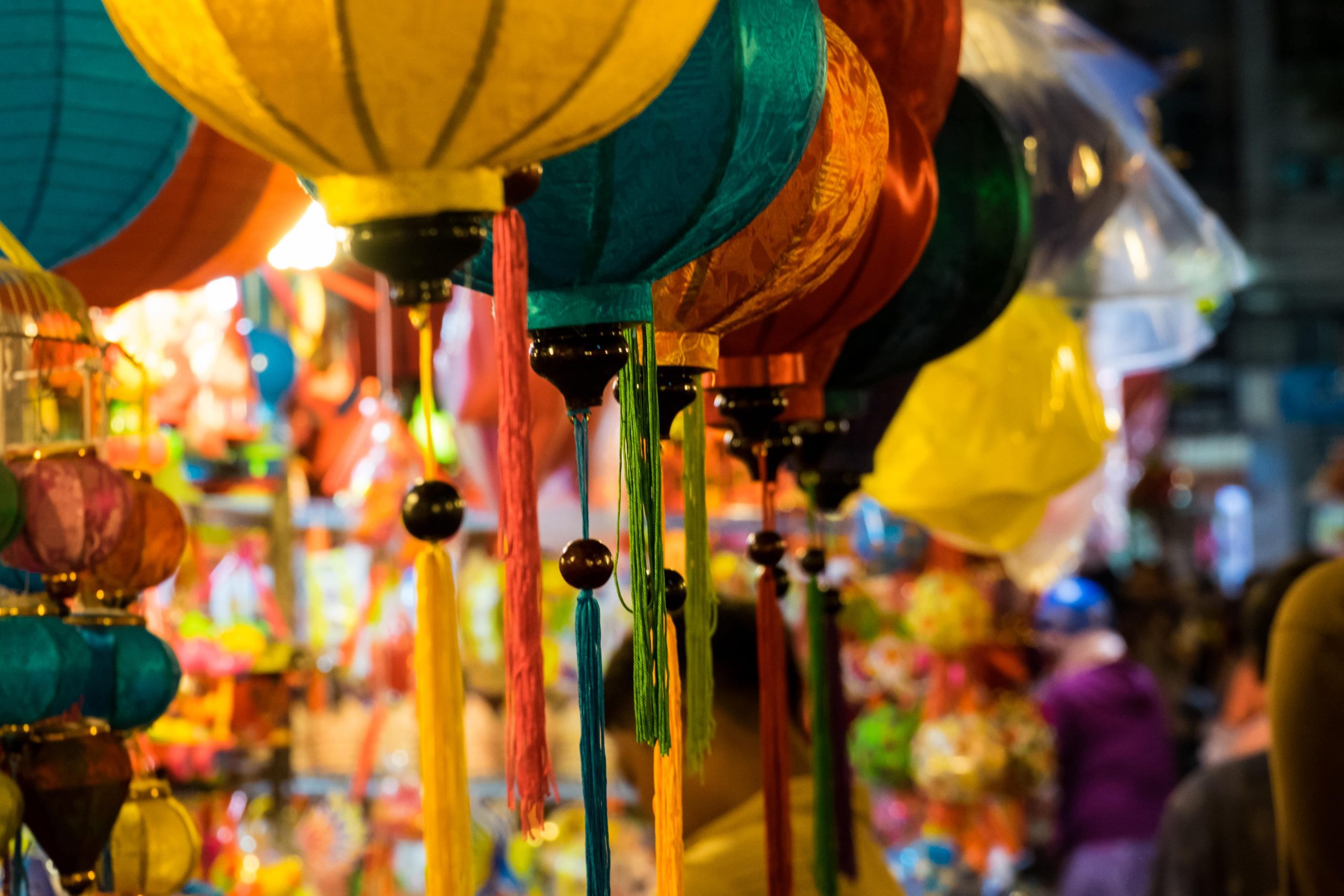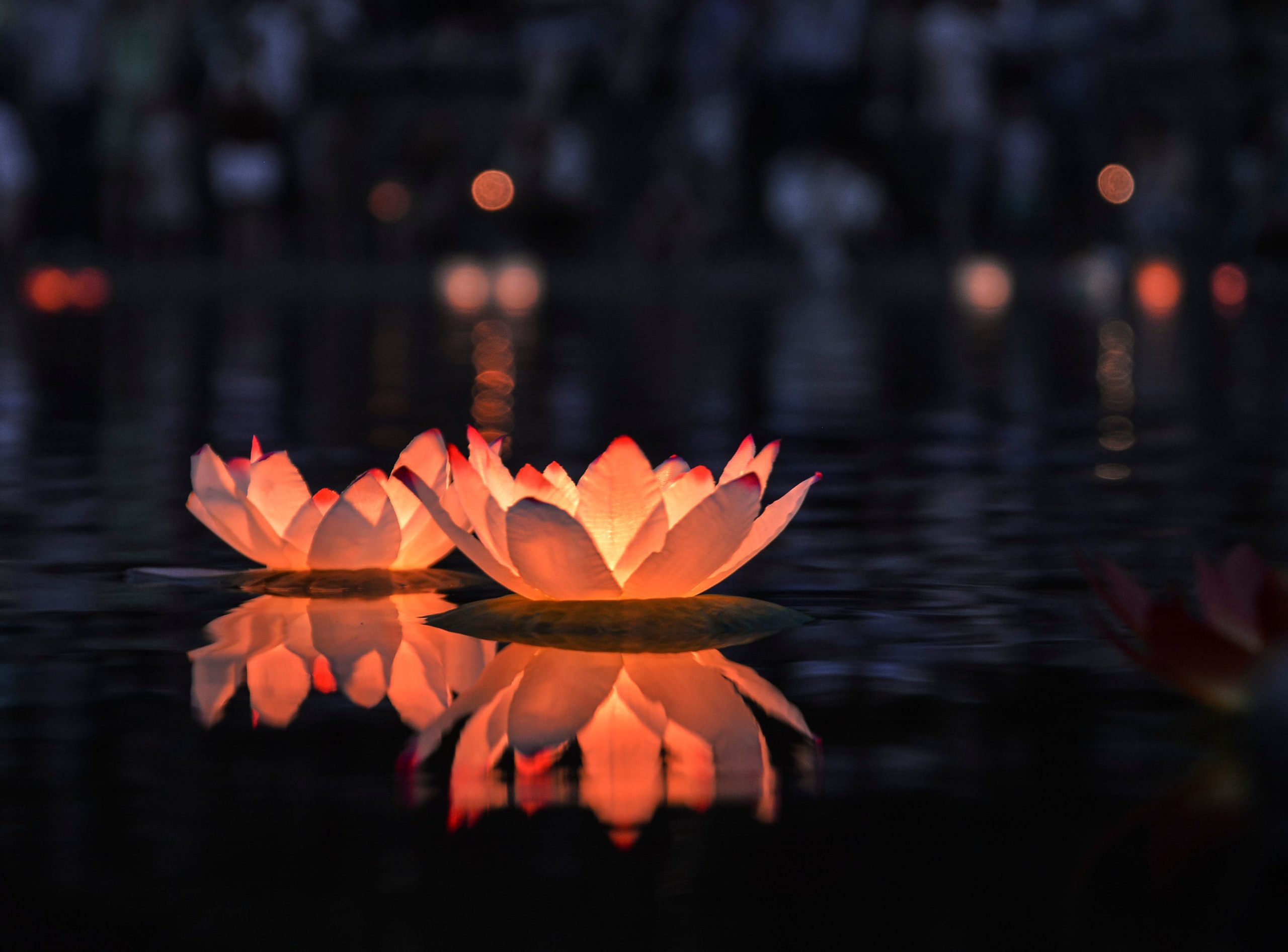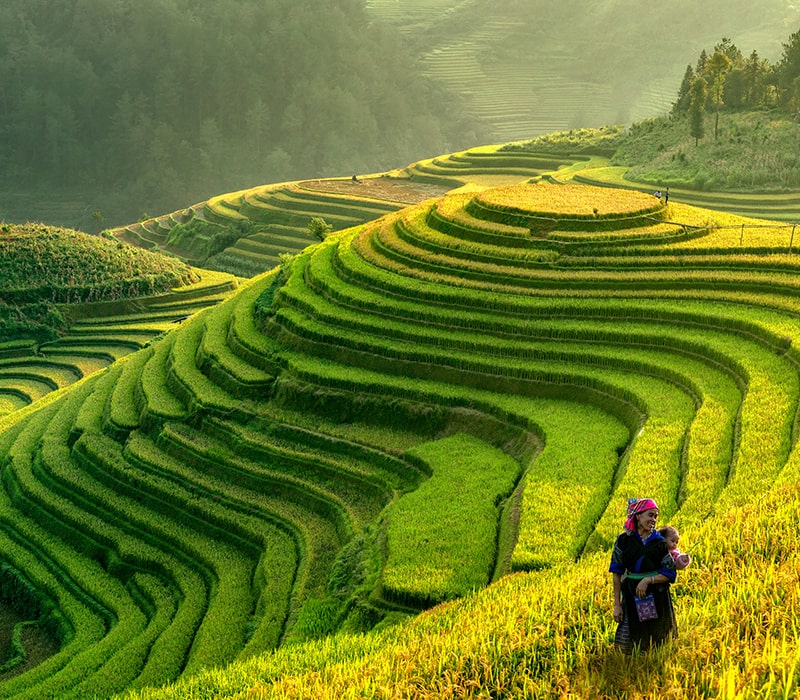Vietnam, renowned for its stunning landscapes and vibrant cultural heritage, invites travellers to embark on an extraordinary adventure year-round. However, selecting the perfect time to visit can significantly elevate your experience, allowing you to enjoy pleasant weather, lively festivals, and captivating activities. In this guide, the local expert from Designer Journeys will highlight the ideal months to discover Vietnam, emphasising these crucial elements.
Post Contents
The Best Months Overall
Choosing the best month to visit Vietnam means thinking beyond just the weather—it’s about crafting a journey that aligns with your style, comfort, and the experiences you want to create. Vietnam, with its tropical climate and distinct regions, offers beauty and excitement in every season, but certain months stand out for those seeking seamless, luxury travel.
For most multi-region trips, March–April and October–November can both offer pleasant, dry weather across two of the three regions. Otherwise, select your timing based on the region:
- Northern: October–November or March–April
- Central coast: January–August; avoid September–December (peak typhoon and heavy-rain season)
- Southern: November/December–April
The dry season in the north and central regions ensures comfortable travel, whether you’re exploring the vibrant streets of the capital city, Hanoi and cruising the emerald waters of Ha Long Bay, or unwinding on the beaches of the central coast.

Choosing the best month to visit Vietnam that matches your style, comfort, and desired experiences.
Further south, Ho Chi Minh City, the vibrant heart of southern Vietnam, and the surrounding Mekong Delta and Phu Quoc Island, are best enjoyed during the southern dry season, from December through March. Here, you’ll find typically warm, sunny days, and little rain—ideal for discovering floating markets, lounging on the sand with a beach towel, or exploring the tropical islands of the far south. Even during the peak season, you can enjoy fewer crowds by designing your itinerary to include the southern islands or Con Dao National Park.
Are you planning a trip to Vietnam?
Browse our gallery of fully customisable Vietnam itineraries and connect with one of our expert Local Designers to get you started! Designer Journeys can design your ultimate experience and offers hand-crafted itineraries built by experienced Local Designers who have first-hand knowledge of the destination.
Discover Vietnam by Region
This vibrant description of Vietnam serves as a powerful source of inspiration for travellers seeking diverse and authentic experiences. It highlights the country’s rich tapestry of regions, each with its unique climate, culture, and adventures, encouraging exploration and personalised journey planning. Let’s explore north, central, and south Vietnam—each with its unforgettable seasons and signature experiences.
Northern Vietnam: Mountain Majesty, Culture & Crisp Skies
Northern Vietnam is where the country’s distinct seasons are most dramatic. From the energetic streets of the capital city, Hanoi, to the mystical waters of Ha Long Bay and the rugged beauty of the mountainous far north, this region is an explorer’s dream, especially from October to April.
During this dry season, northern regions enjoy cooler temperatures, clear skies, and the kind of crisp, temperate climate that makes walking, cycling, and scenic cruising a pure pleasure. Imagine starting your day with sunrise over Ha Long Bay’s limestone islands, or exploring the ancient alleyways of Hanoi as local life stirs awake—this is classic Vietnam at its most enchanting. The summer season (June to August), however, marks the wet season, with frequent rain and higher humidity. While the countryside turns a brilliant green and the rice terraces of Sapa shimmer under the monsoon season, downpours can limit some activities.

Halong bay is one of the UNESCO-listed of Vietnam.
In the mountainous regions and the far north, from Sapa to Ha Giang, temperatures can dip sharply in winter, especially at higher altitudes. For those seeking a unique experience, visiting during the Perfume Pagoda Festival (January to March) offers a chance to join local pilgrims amid stunning natural scenery.
Best time to visit Northern Vietnam: October to April for dry weather and cultural events; June–August for adventure and lush landscapes (but expect rain).
Central Vietnam: Sun, Sand & Timeless Culture
Central Vietnam is where beach lovers and culture seekers unite. The central coast—featuring iconic destinations like Da Nang, Hoi An, and Nha Trang—boasts some of Southeast Asia’s best beach weather. From February to August, this region is bathed in sunshine, with clear blue skies and crystal clear waters ideal for a luxury beach vacation.
March and April are especially prized for pleasant temperatures and low rainfall—perfect for exploring Hoi An’s ancient town, relaxing on the sand with a beach towel, or diving into the vibrant life of Nha Trang. As you imagine yourself wandering through lantern-lit streets or lounging on the coast, know that this is the high season for central Vietnam—book ahead for the best experiences.

Vietnam is home to some of the most beautiful beaches in Southeast Asia.
The wet season or typhoon season typically runs from September to December, sometimes extending into January, bringing heavy rain and the occasional flooding, especially in the central region. For those seeking cultural insight, the Mid-Autumn Festival in September transforms Hoi An into a glowing wonderland of lanterns, while Wandering Souls Day in October offers deep connections to local traditions.
Best time to visit Central Vietnam: February to August for sunny weather and beach escapes; avoid October–November’s storms for a seamless experience.
Southern Vietnam: Warmth, Waterways & Island Adventures
In the far south, Ho Chi Minh City and the lush Mekong Delta set the scene for an entirely different adventure. Southern Vietnam enjoys a tropical climate with two distinct seasons: the dry season (December–March) and the wet season (May–October).
The dry weather months bring sunny days and typically warm temperatures, making it the best time to visit Vietnam’s southern highlights. Glide through the floating markets of the Mekong Delta, soak up the sun on Phu Quoc Island or the untouched beaches of Con Dao National Park, and savour Ho Chi Minh’s vibrant energy without the interruption of rain. This is when southern islands are at their most alluring, and beach vacations promise crystal clear waters and fewer crowds.

Southern Vietnam with a tropical climate, remaining warm year-round.
As the wet season arrives, the countryside comes alive with lush green rice fields and tropical blooms. While showers are frequent, they often pass quickly—travellers who embrace the summer months can discover authentic local life, low-season bargains, and the chance to experience Vietnam’s natural abundance.
Best time to visit Southern Vietnam: December to March for clear skies and the ultimate in comfort and convenience; May–October for a more adventurous, green, and tranquil experience.
Expert Tip: With each region revealing its best side at different times, the key to a seamless, personally crafted journey is knowing when and where to go.
Festivals & Cultural Experiences
Vietnam is a country rich in culture and tradition, with numerous festivals celebrated throughout the year. Many of these events are deeply rooted in Vietnamese customs, reflecting the nation’s spiritual beliefs, folklore, and historical milestones. Experiencing Vietnam during one of its major festivals offers travellers a unique opportunity to witness local traditions, colourful performances, and vibrant street celebrations. Below, we explore some of the most significant festivals and the best months to experience them.
Tết (Vietnamese Lunar New Year)
Tết, or Tết Nguyên Đán, is the most important and widely celebrated holiday in Vietnam, marking the beginning of the lunar calendar. Usually falling between late January and early February, this festival is equivalent to Christmas and New Year combined in the Western world.
During Tết, cities and towns across the entire country come alive with festive decorations, red lanterns, and blooming peach blossoms in the north, while yellow apricot flowers dominate in the south. Families clean and decorate their homes, honour their ancestors, and prepare traditional foods like bánh chưng (square sticky rice cake) and bánh tét (cylindrical sticky rice cake). The festival also features fireworks displays, dragon dances, and the giving of lì xì (red envelopes filled with lucky money) to children.

Vietnamese family members making Banh Chung together.
While Tết is a fascinating time to visit Vietnam, many businesses, restaurants, and attractions close for at least a few days as locals spend time with family. However, if you’re in cities like Hanoi, Ho Chi Minh City, or Hue, you’ll witness lively celebrations, public performances, and firework displays.
Perfume Pagoda Festival – February to March
Located in northern Vietnam, the Perfume Pagoda Festival is one of the most significant Buddhist pilgrimages in the country. Held from the 15th day of the first lunar month until the third lunar month (usually February to March), this festival attracts thousands of devotees who journey to the sacred Huong Temple, nestled in the limestone mountains of Hà Tây Province near Hanoi.

Traditional Huong Pagoda Festival.
Image source: VOV
To reach the pagoda, you must take a boat ride along the scenic Yen River, followed by a hike or cable car ride up the mountain. Along the way, pilgrims pray for good fortune, health, and prosperity. The festival offers an immersive spiritual experience combined with breathtaking natural landscapes.
Hùng Kings’ Festival – 10th day of the 3rd lunar month
Celebrated in April (in 2025, this falls on April 7), the Hùng Kings’ Festival honours Vietnam’s legendary founders, the Hùng Kings. The festival takes place at the Hùng Temple in Phú Thọ Province, where locals and visitors gather to pay tribute to the first rulers of Vietnam.

The Hùng Kings’ Festival honours Vietnam’s legendary founders, the Hùng Kings.
Traditional processions, dragon dances, and ceremonial offerings fill the day, while cultural performances showcase Vietnam’s long history. This festival is an excellent opportunity to learn about Vietnam’s origins and national pride.
Mid-Autumn Festival – September or October
The Mid-Autumn Festival, known as Tết Trung Thu, takes place on the 15th day of the eighth lunar month (usually September or October). This is one of Vietnam’s most family-friendly celebrations, focusing on children and their happiness.

The streets are adorned with colourful lanterns.
In cities like Hoi An, Hanoi, and Ho Chi Minh City, streets are adorned with colourful lanterns, and children carry star-shaped lanterns while parading through the streets. The festival also features lion and dragon dances, storytelling sessions, and the sharing of mooncakes—a traditional delicacy symbolising unity.
Hoi An is particularly famous for its Lantern Festival during the Mid-Autumn Festival, when thousands of lanterns illuminate the ancient town, creating a magical atmosphere.
Vietnam National Day – September 2nd
Vietnam National Day celebrates the country’s independence from France on September 2nd, 1945. It is a time of national pride, marked by flag-raising ceremonies, parades, and fireworks across the country.

Independence Palace, Ho Chi Minh.
The biggest celebrations take place in Hanoi, where a military parade is held in Ba Dinh Square, and in Ho Chi Minh City, where fireworks light up the skyline. While it’s an exciting time to visit, travellers should expect crowds, traffic restrictions, and higher demand for accommodations.
Wandering Souls Day (Vu Lan) – 15th day of the 7th lunar month
Wandering Souls Day—known locally as “Vu Lan” or “Trung Nguyen”—is one of the most moving and spiritual cultural events in Vietnam, often observed in late August, depending on the lunar calendar. This meaningful festival, deeply rooted in Buddhist tradition, is sometimes called the “All Souls’ Festival.” It’s celebrated across the entire country but holds special significance in northern and central Vietnam, where family bonds and ancestral respect are at the heart of daily life.
On Wandering Souls Day, Vietnamese families believe that the gates between worlds open for about a week, allowing the souls of the departed to return and visit their loved ones. Homes, temples, and pagodas are adorned with offerings of food, incense, and flowers—designed to support wandering spirits on their journey. The air is filled with the scent of burning joss sticks, the gentle glow of lanterns, and the sound of prayers echoing through ancient temples, especially in mountainous regions where tradition remains strong.

Wandering Souls Day is one of the most moving and spiritual cultural events in Vietnam.
It’s a period of reflection and gratitude. Locals design elaborate ceremonies at home and in community pagodas, inviting monks to chant and lead rituals. Special foods are prepared, including sticky rice cakes and fruit, and families gather to remember ancestors with both solemnity and warmth. In many communities—especially in the central coast and the mountainous far north—local markets and street vendors add a festive layer, offering treats and flowers for last-minute rituals.
Design your perfect Vietnam trip today!
Work with your expert local travel designer to customise your itinerary so it is exactly what you want from a Vietnam trip. Get exclusive experiences, top-rated restaurants, and hotels that fit your interests.
Month-by-Month Climate & Highlights
| Month | North (Hanoi) | Central (Da Nẵng/Hoi An) | South (HCMC) | Highlights |
|---|---|---|---|---|
| Jan | 16°C / 19mm – Cool, dry | 22°C / 96mm – Mild | 26°C / 15mm – Dry | Perfume Pagoda Festival, cultural events |
| Feb | 17°C / 26mm – Pleasant weather | 23°C / 25mm – Dry | 27°C / 4mm – Sunny days | Tet Nguyen Dan (dates by lunar calendar) |
| Mar | 20°C / 46mm – Warm | 25°C / 49mm – Beach weather | 28°C / 10mm – Dry | Exploring Hoi An’s lantern nights |
| Apr | 24°C / 91mm – Warm | 27°C / 55mm – Best beach weather | 29°C / 50mm – Warm | Hue cultural events |
| May | 28°C / 196mm – Humid | 29°C / 83mm – Sunny | 29°C / 218mm – Start wet | Low season for fewer crowds |
| Jun | 29°C / 239mm – Hot | 30°C / 91mm – Hot | 28°C / 310mm – Wet | Beach towel & summer fun |
| Jul | 29°C / 288mm – Wet | 31°C / 99mm – Warm | 27°C / 293mm – Wet | Southern Vietnam island trips |
| Aug | 28°C / 310mm – Wet | 31°C / 107mm – Warm | 27°C / 270mm – Wet | Mid-Autumn Festival prep |
| Sep | 27°C / 265 mm – Cooler | 29°C / 358 mm – Peak rain & storm season | 27°C / 327 mm – Wet | Typhoon risk in Central Vietnam |
| Oct | 25°C / 130 mm – Pleasant | 27°C / 650 mm – Heaviest storm & flooding risk | 27°C / 294 mm – Wet | Avoid the Central Coast due to typhoons |
| Nov | 22°C / 47 mm – Cool | 25°C / 235 mm – Continued rainy season | 27°C / 116 mm – Drying | Ongoing flood risk in the Central region |
| Dec | 18°C / 19 mm – Cool, dry | 23°C / 215 mm – Mild | 26°C / 50 mm – Dry | High-season beach holidays |
F.A.Qs
What are the best and worst months to visit Vietnam?
The best months are March–April for pleasant temperatures, dry weather, and sunny skies. In contrast, the worst months are October–November in the central coast (typhoon season) and June–August in north Vietnam (wet season).
Which season is best for tourists in Vietnam?
Spring (Feb–Apr) offers pleasant weather and clear skies in most regions, making it the best time to visit.
What is the rainy season for Vietnam?
In the north and south, the rainy season runs May–Oct; in the central region, it’s Sep–Dec, with two distinct seasons split by dry season months.
What is the cheapest time to visit Vietnam?
Late Apr–May and Sep–early Oct are low season with fewer crowds and low season bargains, while still offering typically warm days.
Don’t Miss Our Exclusive Offers! Subscribe Today!
For the ultimate travel inspiration, local insight straight from our expert Local Designers and exclusive offers you won’t find anywhere else from Designer Journeys, sign up today! Don’t miss out.
Vietnam is a land of vibrant diversity, with a climate that shifts beautifully across its regions and a cultural calendar filled with colourful festivals and events. No matter the season, there’s always something enchanting waiting for you. By tuning into the local weather patterns, marking significant festival dates, and reflecting on your personal interests, you can choose the perfect time to set off on an unforgettable adventure through the heart of Vietnam.
Looking for a month-by-month breakdown of visiting Vietnam? Explore our Vietnam travel guide for an unforgettable journey.









